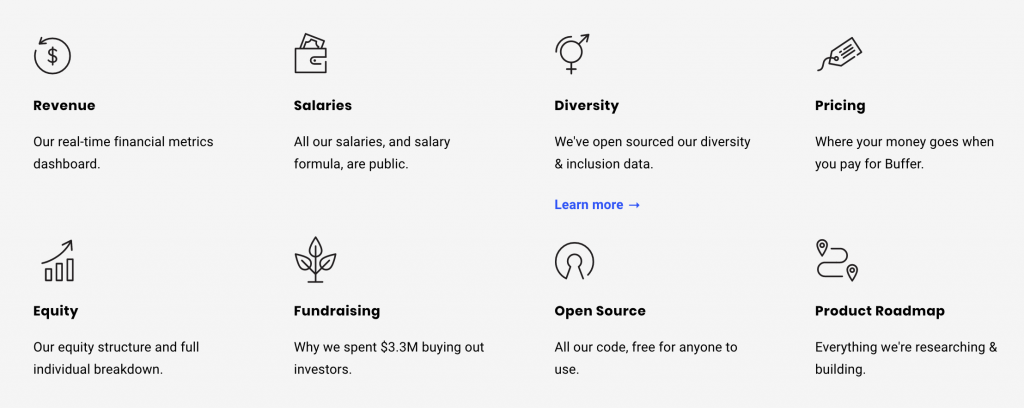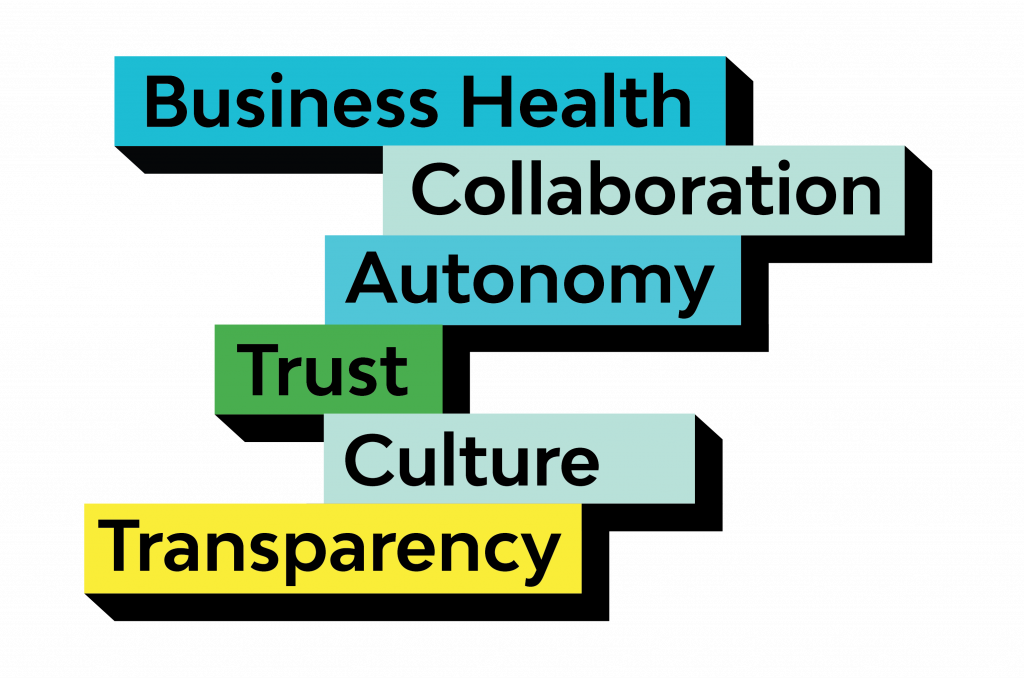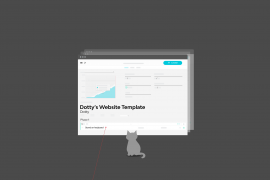There’s a trend bubbling away in many industries at the moment. Transparency. Sharing the full inner workings of your business with your employees.
It is scaring the proverbial crap out of some business owners, while others are embracing it 110%.
In designing Streamtime, we wholeheartedly led with transparency as a principle. Over time, we’ve bowed to some requests to hide certain data away from team members. But wherever possible we advocate for sharing more than less. So how transparent should your business be?
Sharing is caring
In our business, we share virtually everything. Every minute of every day, everyone can see how subscriptions are performing, pipeline is tracking and product is developing. Once a month, we update the team on financial performance against what we planned at the beginning of the year. As a result, everyone’s informed and can ask questions at any time about the health of our business.
We’re not concerned about this information being used against us as a business. In fact, the opposite. We believe that it instils more trust in our team and helps them to feel a part of our company.
I’ve practised this in agencies as well. The result has always been that of appreciation. Sometimes you could argue that when the news isn’t positive, it’s too much of a burden on people. However, on the whole, I’ve found that they’d rather know than be caught off-guard by what may be seen as hasty knee-jerk decisions affecting people’s personal health or financial situations.
Barriers to transparency
This isn’t the case for every business though. Of course, we’re all different. We all have what we think are our own best practices for running a successful business. We’ve heard many reasons from customers about why they’d prefer for staff to not have access to certain financial information. They include…
I don’t want my staff to see their rates as they’ll think I’m profiting too much from their work.”
“I don’t want anyone to be able to download information about our business and clients and leave with it.”
“My staff don’t need to know how much money we’re making—it’s none of their business.”
“I want people to focus on the work, not the business. I don’t want them distracted by things they don’t understand.”
Some of these arguments are fair enough. But, let’s pose a few questions back.
If they really wanted to, couldn’t staff take photos of screens, write down notes about confidential information they’ve seen, and just pack up and take that info with them?”
“Do you think your staff would feel exploited if they found out their hourly sell rate and compared it to their salary?”
“Do you think your staff aren’t invested in the health of a business that they’re spending half of their waking hours contributing to?”
Inflammatory responses maybe. But what if we assume some goodwill and that the talent we’ve hired wants to see the business they work for do well? They want you to succeed and that correlates with their own success.
I think it’s safe to assume in our industry that there aren’t any CEOs earning 275 times the average full-time wage. 🥴. So let’s take a look at the case FOR transparency.
Putting it all out there
Whenever I think of transparency, I often turn to Buffer (the social media publishing platform), who for me, are the Godfathers of transparency. Not only are they transparent in their own business, they’ve opened up their business for anyone and everyone to see. Here are the components that they’ve made transparent in their business.

And yes. You’re reading that right. You can see all of the salaries of every team member in their company.
Transparency is the first of a rather impressive set of values that they have adopted.
Default to transparency
- As individuals, we view transparency as a lifestyle of authenticity and honesty.
- As a team, we view transparency as an effective way to work remotely and establish a culture of trust.
- As a company, we view transparency as a tool to help others.
- We share early in the decision process to avoid “big revelations”.
- We strive to make all communication clear and avoid making assumptions.
Why did Buffer opt for open salaries? Ultimately it’s because transparency builds trust and trust builds stronger teams.
Now, I’m not necessarily advocating for going as far as Buffer and making salaries open for all to see. To be honest, if you’re going to do that you need to have comprehensive and justifiable formulae in place that everyone can agree is fair from a number of perspectives.
But let’s take the main premise of Buffer’s argument. Transparency breeds trust. Isn’t that a good thing?
Trust breeds success
Absolutely. Trust is often quoted as the number 1 driver of a successful relationship. This HBR article about operational transparency quotes numerous case studies where trust has driven better satisfaction and value not just for employees but customers too.

Transparency isn’t just about financials. It’s about relationships as well. We’re seeing many businesses begin to adopt flatter structures, more collaborative working practices and more opportunities provided to more junior members of a team.
For example, taking the people who have actually done the work to client presentations is much more common place now that it was 10-20 years ago when the only people who could see the client were the Head of Client Services, the Creative Director and the CEO. Just like in Mad Men, you can’t smoke in your office anymore, presentations aren’t the exclusive domain of those at the top.
Then there are the benefits of placing that trust in your employees to make better decisions for your business. Decisions that actually make you more money. As this writer argues, handing over more information can build autonomy with knock-on effects for efficiency and profitability – yep! all the buzzwords in that one sentence, right there!
The trend towards transparency is accelerated if you’re starting or transforming your business to be purpose-driven. A pretty smart strategy given purpose is now one of the top considerations in attracting new talent. It’s why our product is always benchmarked against our philosophy: project management for humans, not robots.
Show me everyone the money!
Financial transparency encourages staff to think like business owners. Ultimately, they become more vested in yours and the business’ success.

Beware though. Transparency isn’t a strategy you can adopt overnight. Preparing people for the truth that they’re about to be exposed to needs to be handled carefully. Suddenly telling someone that the business is performing poorly and that redundancies are on the cards needs to be a conversation that’s handled with some consideration.
One of the common arguments against transparency is when it comes to rates. One person being able to compare their ‘worth’ against a colleague ‘sold’ at a higher rate can create envy, a sense of unfairness, or a question about how much less they may be being paid. Again, a conversation to be considered before just opening up free-for-all access.
This situation can also provide a positive opportunity. Rates show that you’re valued by your business. They’re also a way of benchmarking that value. Increasing someone’s rate (and hopefully, in line, their salary) is a great way to prove progression in the value that they provide your business. If your rates are seen by clients, it’s another way for your clients to recognise the value and expertise being provided. There’s a reason the phrase, “you get what you pay for” exists.
You’re paid how much??
I remember when I got my first job in an agency. My rate was $150/hr. I had to plan my own jobs so it was common sense that I needed access to this information. I naively did the maths.
150/hr * 8 hrs/day * 5 days a week * 48 weeks a year = $288,000/yr.
Of course, that wasn’t my salary. And I would often joke about my worth and what a mint the agency was making out of me. As we all know, the calculation isn’t that simple. I, nor any of my friends at the agency kicked up a stink about feeling exploited. I’ve also never heard a tale of anyone else who, on seeing their charge-out rate, demanded an instant inquiry!
Instead, I wore my rate as a badge of pride and devised to work out how I could add more value to get that rate up and be worth more.
Take a step back
Consider some of the examples above and think about if transparency could help (rather than hinder) your business. Trust your people, check your biases and see if a more transparent future could equal a more prosperous future.
Are you interested in software that helps you manage your creative business and can ease you into a more transparent approach? Get in touch with us today.








1 Comment
Thank you for writing such an insightful article. I can see this strategy being applied to any sized business. I currently work full time for a consulting firm and can see how the philosophy of “thinking like a business owner” could really help boost initiative and quality of work in this company.
I also run a side hustle as a freelance graphic designer and can see how this could benefit my clients. Give them an insight as to where their money goes and how much value for money they really do get.
“Transparency” is a trending word on everyones lips at the moment (in my full time job anyway) as we move this business into the modern workforce era. Automate the mundane tasks, work together as “one team” and not in “silos”, transparency and communication is key to better productivity. Reading this only confirms we are moving in the right direction.
I don’t think we’d ever go as far as revealing each others salaries, but I do love that our project financials are open for everyone to see. It means we know where we can do better, which in turn, will only make us more profitable for future projects.
Kudos for a great read 🙂